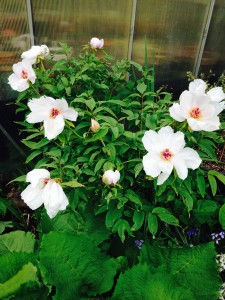Paeonia
- Greg Graves
- May 30, 2023
- 3 min read

Botanical Print
When I think back to my childhood in North Dakota and remember flowers the first ones to come to mind are the Peonies. Both of my grandmothers grew them but I remember the ones in my Grandma Jenny’s garden as being particularly beautiful. I stayed there overnight frequently and she baked every Saturday morning. In-between batches of what ever was baking we would weed and I remember the smell of theses blooms being particularly sweet. I’m sure there is a connection of the doughnuts or fresh bread and that plant. It probably also explains the fact that I don’t really mind weeding. I credit my Grandma Jenny with my love of gardening and it is due I’m sure to the taste of home-made baked goods. I think a lot of gardeners have a connection with food and gardening.

Paeonia obovata ‘Alba’
Anyway, there are two basic groups of peonies, Herbaceous (they die to the ground each year) and tree (woody). There is a third group which is a cross between these two, Itoh, but I’ve only been growing them for a few years so I’m not talking about them. We grow about 30 in the garden of both types. The herbaceous doubles are the ones that most people will be familiar with. They have big double heads and a very sweet smell. We have several in the garden, many from friends so I have a special connection to those specific plants. I’m particularly fond of the species type which tend to have just single petal flowers. They come in several colors, white, red, and yellow but mostly shades of pink. They tend to be a bit sturdier since they don’t have the heavy flower heads, which in the Northwest invariably get knocked down in the rain. Speicies peonies never need staking.

Paeonia veitchii
The blooms on species peonies are always beautiful but normally lack the fragrance of the hybrids. They do however set seed and the seed pods are as showy as the blooms. They resemble a fuzzy little jesters cap. When they pop open they have the most amazing porcelain blue and red seeds. They look like tiny bowls of fruit.

Paeonia mlokosewitschii
You will probably never see blue seeds here at Old Goat Farm. The blue seeds are the fertile ones and if collected in the first few days and sowed they will come up the next spring. If the seeds has a chance to harden then they have a double dormancy, which means it takes two years to germinate. I like to grow peonies from seed and have around 4 or 5 hundred in various stages in the back nursery. It takes about 7 years to get a bloom size plant from seed. That may be one reason you rarely see them offered at most of the big nurseries, too much time invested. The species I grow are, officinalis, japonica, mairei, macula, obovata alba, miokosewitschii, ruprechtiana, veitchii and wittmannianna. All of theses are in the garden so I’m always watching for the seed.

Paeonia lactiflora ‘Karen Gray’
A couple are particular favorites, veitchii and mascula. I had a chance to see both of these growing in the wild.I saw mascula while on a hike in Sardinia and veitchii while on a hike in Tibet. To be in these very different environments and see plants that were familiar to me stopped me in my tracks. Now they have the same effect when walking in my own garden. Seeing them reminds me of those amazing adventures.
Seeing Peonies in the garden always evoke memories and all good.

Paeonia obovata ‘Alba’ in the landscape

Paeonia suffruticosa

Unknow tree peony cultivar

Paeonia lutea var. Ludlowii

Paeonia suffruicosa – white form

Paeoina lactiflora ‘Sarah Bernhardt’

Paeonia wittmanniana

Paeoina mairei in the landscape


Comments